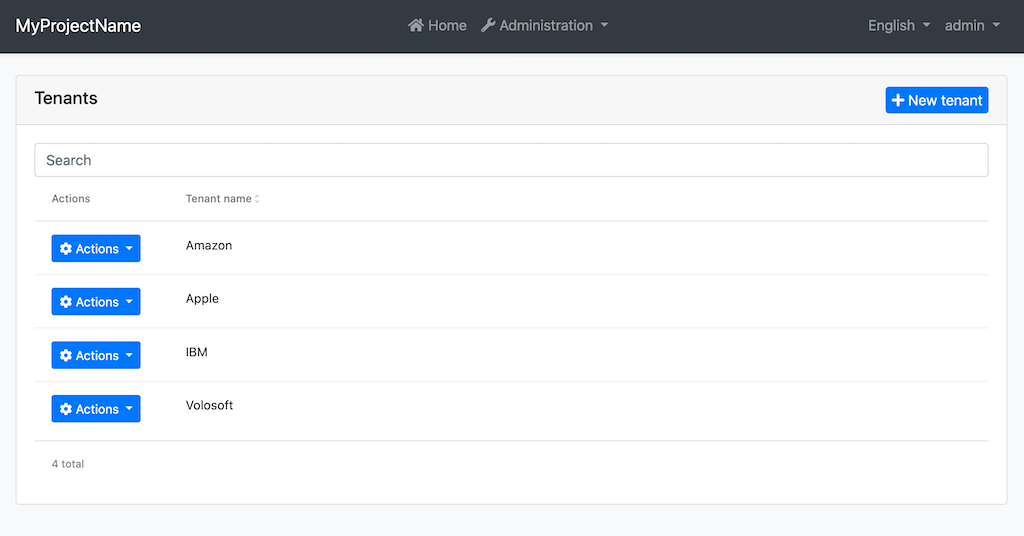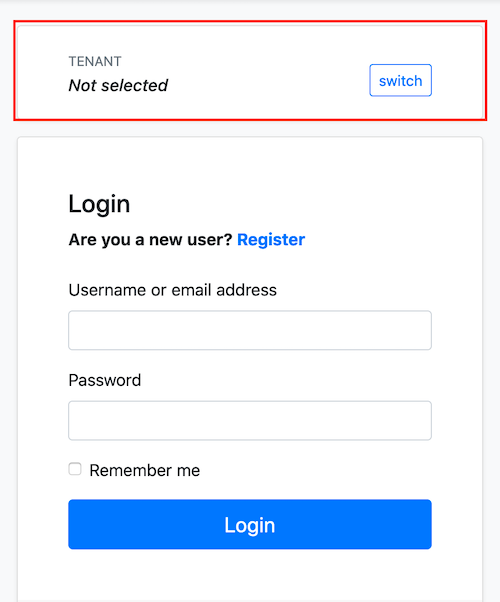Multi-Tenancy in Angular UI
ABP Angular UI supports the multi-tenancy. The following features related to multi-tenancy are available in the startup templates.

Tenants page
On the page above, you can;
- See all tenants.
- Create a new tenant.
- Edit an existing tenant.
- Delete a tenant.

Tenant Switching Component
You can switch between existing tenants by using the tenant switching box in the child pages of the MVC Account Public Module (like Login page). Angular UI gets selected tenant from application-configuration response and sends the tenant id to the backend as __tenant header on each request.
Domain/Subdomain Tenant Resolver
Note: If you are going to implement the steps below, you should also implement the domain/subdomain tenant resolver feature for the backend. See the Domain/Subdomain Tenant Resolver section in Multi-Tenancy document to learn the backend implementation.
Angular UI can get the tenant name from the app running URL. You can determine the current tenant by subdomain (like mytenant1.mydomain.com) or by the whole domain (like mytenant.com). To do this, you need to set the application.baseUrl property in the environment:
Subdomain resolver:
// environment.prod.ts
export const environment = {
//...
application: {
baseUrl: "https://{0}.mydomain.com/",
},
//...
};
{0} is the placeholder to determine current tenant's unique name.
After the configuration above, if your app runs on the mytenant1.mydomain.com, the app will get the tenant name as mytenant1. Then, the app will call the /api/abp/multi-tenancy/tenants/by-name/mytenant1 endpoint to check if the tenant exists. If the tenant (mytenant1) exists, the app will keep this tenant data and send its id as __tenant header to the backend on each request. If the tenant does not exist, the app will not send __tenant header to the backend.
Important Note: If you define the
baseUrlwith the placeholder ({0}), the tenant switching component in the child pages of theAccountLayoutComponent(like Login page) will be hidden.
Domain resolver:
// environment.prod.ts
export const environment = {
//...
application: {
baseUrl: "https://{0}.com/",
},
//...
};
After the configuration above, if your app runs on the mytenant.com, the app will get the tenant name as mytenant.
Tenant Specific Remote Endpoints
The {0} placeholder can be put to the API URLs in the environment to determine tenant specific endpoints.
// environment.prod.ts
export const environment = {
//...
application: {
baseUrl: "https://{0}.mydomain.com/",
//...
},
oAuthConfig: {
issuer: "https://{0}.ids.mydomain.com",
//...
},
apis: {
default: {
url: "https://{0}.api.mydomain.com",
},
AbpIdentity: {
url: "https://{0}.identity.mydomain.com",
},
},
};
Important Note: The
application.baseUrland the{0}placeholder in the value of thebaseUrlproperty are required to be able to get tenant from running URL. Other placeholders in API URLs are optional.
After the configuration above, if your app runs on the mytenant1.mydomain.com, the app will get tenant name as mytenant1 and replace the environment object in EnvironmentService on app initialization as follows:
// environment object in EnvironmentService
{
//...
application: {
baseUrl: 'https://mytenant1.mydomain.com/',
//...
},
oAuthConfig: {
issuer: 'https://mytenant1.ids.mydomain.com',
//...
},
apis: {
default: {
url: 'https://mytenant1.api.mydomain.com',
},
AbpIdentity: {
url: 'https://mytenant1.identity.mydomain.com',
},
},
}
After this replacement, the app will use the following URLs:
https://mytenant1.ids.mydomain.comas AuthServer URL.https://mytenant1.api.mydomain.comas default URL.https://mytenant1.identity.mydomain.comasAbpIdentityremote endpoint URL.
The app sends the __tenant header that contains the current tenant id on each request.
Handling Domain-based Tenant not found
When the application is initialized and a domain-based tenant is active, it makes a request for to validate the tenant. If it cannot be located, the Angular application calls the function. The function displays an error message, but the functionality can be customized by injecting the TENANT_NOT_FOUND_BY_NAME token into the function.
Example:
import { TENANT_NOT_FOUND_BY_NAME } from '@abp/ng.core';
@NgModule({
imports: [
// removed for clarity
],
providers: [
// removed for clarity
{
provide: TENANT_NOT_FOUND_BY_NAME,
useFactory: function () {
return () => {
window.location.replace('https://abp.io');
};
},
},
],
declarations: [AppComponent],
bootstrap: [AppComponent],
})
export class AppModule {}


























































